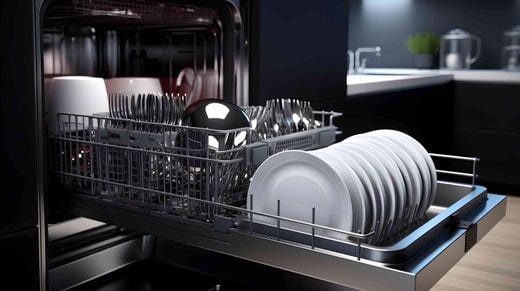
Do You Point Cutlery in Dishwasher Up or Down?

When it comes to using a dishwasher, it’s not always as simple as “load and goes”. There’s actually an art to loading the dishwasher, and it will look different depending on the brand, model, utensils, dishware, and your favorite cutlery.
From caring for your precious silverware to ensuring your expensive knives don’t dull, it’s important to understand how to load and clean cutlery in order to get optimum results.
But there’s an age-old argument that can still fire up family members and divide offices - should you point cutlery in dishwasher up or down?
While some prefer putting them facing down, many decide to go the other way, and some like to go both ways. So, in this article, we try to settle this debate once and for all.
What does the dishwasher manual say?
Let's see what some of the most popular dishwasher manufacturers have to say about the cutlery up or down.
- The LG manual advises placing forks and spoons upward, while knives should be positioned downward for safety purposes.
- Bosch suggests keeping cutlery "always unsorted with the tips facing down, in the cutlery basket," placing "long, pointed tools and knives on the knife shelf."
- Midea recommends placing knives and other utensils with sharp points loaded in the basket with their points facing down or placed in a horizontal position.
The case for loading cutlery pointing up
Most modern-day dishwashers include separators in their silverware baskets to create distance between utensils. When you place the silverware into these dividers, the slots are made to secure the bottom of the spoon and fork, positioning their tops upwards.
This approach prevents the utensils from nesting together, ensuring better water circulation between them during the wash cycle.
The case for loading cutlery pointing down
Loading the cutlery pointing down offers safety as the blades are facing downwards, so you don’t accidentally grab them.
Another advantage is that it’s easier to unload items if their handles are facing up. Also, pointing your items down—with the handles up—is perceived as a more hygienic method.
The only drawback of this approach is that it's easier to overcrowd your dishwasher's silverware basket because the tines of forks or the curved part of spoons occupy more space than their handles.
The verdict: which is best, up or down?
While we prefer not to remain neutral, we'd recommend both approaches. Sharper tools should always be positioned with the blade down—although you might consider avoiding putting them in the dishwasher altogether to prevent dulling, but that's a separate discussion.
For everything else, arrange them in an alternating fashion, some facing up and some facing down, to prevent them from nesting and to optimize cleaning results. Although unloading might take a bit longer, the effort is worthwhile for superior cleanliness.
Remember, for the best dishwashing experience, always choose the best dishwasher detergents - recommended by the leading dishwasher brands - to guarantee an optimal dishwashing experience in spotless, sparkling, and shiny dishes.
What you might not know about your dishwasher?
There are certain things you should never put in the dishwasher and other items that may surprise you that can be washed in this appliance. Here are some things you might not know about your dishwasher.
- Numerous items might not be suitable for a dishwasher cycle. Whether it's delicate hand-painted designs or the risk of dulling knives with excessive dishwasher use, adhering to a few guidelines can help preserve essential kitchen items.
- If you have hard water problems (water with high mineral content), Finish Dishwasher Salt can help. It neutralizes the mineral content and effectively softens water to ensure better cleaning performance of your detergent, preventing white residue marks from hard water on your glasses and dishes.
.png?width=70&height=45&format=png&quality=50)


